Book contents
- Frontmatter
- Dedication
- Contents
- List of Images
- Preface
- Acknowledgements
- List of Abbreviations
- Introduction: Towards a Feminist Reading of the Making of the Constitution
- 1 In the Shadow of the Founding Fathers
- 2 In Search of the Missing Mothers
- 3 Women’s Moral Imaginary and Constitutional Politics: 1927–1946
- 4 Patterns of Participation: Women Members in the Constituent Assembly
- 5 Writing the Rights: Inscribing Constitutional Morality
- 6 Reformulating the ‘Woman Question’: Challenging Customs and Traditions
- 7 After the Framing
- Conclusion: Remembering the Founding Mothers
- Appendix: Texts and Contexts of the Framing – A Timeline
- Bibliography
- Index
4 - Patterns of Participation: Women Members in the Constituent Assembly
Published online by Cambridge University Press: 27 September 2022
- Frontmatter
- Dedication
- Contents
- List of Images
- Preface
- Acknowledgements
- List of Abbreviations
- Introduction: Towards a Feminist Reading of the Making of the Constitution
- 1 In the Shadow of the Founding Fathers
- 2 In Search of the Missing Mothers
- 3 Women’s Moral Imaginary and Constitutional Politics: 1927–1946
- 4 Patterns of Participation: Women Members in the Constituent Assembly
- 5 Writing the Rights: Inscribing Constitutional Morality
- 6 Reformulating the ‘Woman Question’: Challenging Customs and Traditions
- 7 After the Framing
- Conclusion: Remembering the Founding Mothers
- Appendix: Texts and Contexts of the Framing – A Timeline
- Bibliography
- Index
Summary
I remember Dr. Ambedkar remarking during the debate on the revised budget proposals, pointing at me, ‘this woman has a bee in her bonnet’. He classified women into three categories – females, women, and ladies, and placed me in the category ‘women’!
—Durgabai Deshmukh, Chintamani and I, 1981Every member has the right to be inconsistent.
—Rajendra Prasad, Chairman, Constituent Assembly, 28 August 1947EVOLVING STRATEGIES, MAKING JUDICIOUS CHOICES
The established conventions of reading the Constituent Assembly Debates are marked by an engagement with the exterior of the Constituent Assembly – the Library Hall of the Parliament Building which hosted more than 300 members, dozens of secretarial staff, reporters and other members of the Indian and foreign press, general visitors, and guests, while the debates were taking place. Think of the grand architecture of this space, with its 13 arc-shaped rows clasped on each other in circles of elevated wooden benches, facing an enclosed dais with an imperial elevation on which is seated the chairman, a widely respected patriarch of conservative sympathies. On either side of this dais, below him, are seated seasoned bureaucrats, providing secretarial assistance to the members among whom are Ministers of the first Cabinet of Independent India. At the centre of the hall, an enormous candelabrum is suspended, from the 80-foot high dome. For a woman member, one of ‘the back-benchers of this house’, to speak is to walk on the green carpet up to the front and mount the rostrum which has one of the two microphones in the Hall – the other reserved for the chairman – and speak to a crowd of argumentative men, literally taking the floor, amid the sound of 40 fans and, in prolonged Delhi winters, that of several heaters.
The absence of the voice of a woman member in the annals of the debates conducted on this floor is no surprise and should be read as evidence of the inherently patriarchal architecture of the Constituent Assembly. A woman's voice, of course, is evidence of the resistance against it. We must remember this architecture when we hear of their presence or absence. There are plenty of instances of both.
- Type
- Chapter
- Information
- Founding Mothers of the Indian RepublicGender Politics of the Framing of the Constitution, pp. 121 - 166Publisher: Cambridge University PressPrint publication year: 2023

